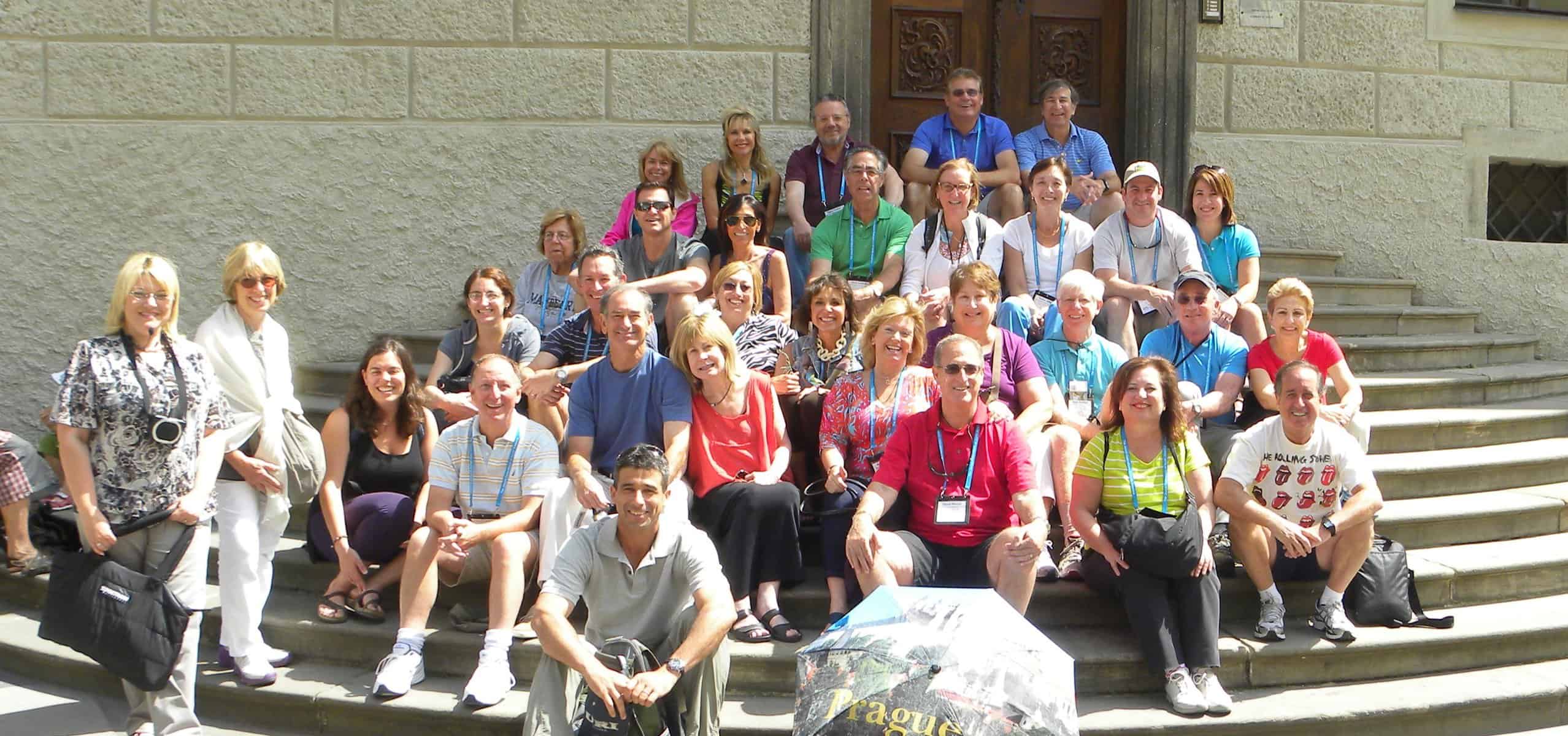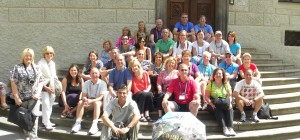In 2000, at the age of 11, Ina’s neighbor told her that she was a Jew. Confused by the comment, she went home and asked her parents for the truth. “How is this possible?” she asked. Growing up Christian, she went to church with her mother. Without saying a word, her father only nodded “yes.” It was her mother who encouraged her to go to Sarvacz, a Jewish summer camp in Hungary.
Last month, on July 14, 29 of us began our weeklong journey to Budapest and Prague. As participants on a United Jewish Federation of Tidewater Mission, we heard stories like this one over and over again. The search for Jewish identity continues to be a part of our people’s Eastern European heritage.
Weaved into our sightseeing, our blossoming friendships, our laughter and conversations, a memorable Shabbat dinner and presentations from professionals and agency leaders, we saw the magic of today’s two Eastern European cities as we learned about the history of the Jews before and after World War II . Through the twists and turns of fate placed in the hands of the countries’ rulers, the presence or absence of a person’s name became the marker for prosperity or tragedy known to the Jewish community.
Prague is a city whose streets read like a history book. Walking into the old town from our hotel, we passed through the city’s gate described by our guide, Uri, as the shape of a Havdallah spice container. He professed that the sovereignty and separation of the city’s regal archway is no different then the theme of the ceremony which separates Shabbat from the rest of the week. Uri, a rabbi’s son and resident of Israel, had the uncanny ability to transform the mundane into the spiritual as we moved from site to site.
For the past 1,000 years, “Praha” has escaped the devastation of war which makes its architectural composition quite unique. The heavy stone walls of the Romanesque churches stand in splendor next to slender pinnacles of Gothic churches. Renaissance town houses are neighbors to baroque facades. And today, modern design is intermingled within the street blocks and cobblestone squares.
It was easy for us to imagine life before World War II while we were in the Czech Republic. The Precious Legacy Exhibit in the Jewish Museum exhibited priceless treasures and everyday possessions. On our museum tour, we stopped to admire a magnificent tapestry. The use of miniature pearls against the luxurious quilted fabric spelled out the name of a prominent synagogue member who had donated the decorative table cover. Pausing to reflect, we thought of the opulence and pride of the community as it must have existed.
Seemingly awkward at first, we learned that members of the Jewish community had inscribed their names on their possessions so that they could reclaim them once the community’s reconstruction in the early 1900s was completed. Ironically in 1942, members of the same Bohemia and Moravia community suggested to the Nazis that their valuables be stored safely in the building, while they were forced to temporarily live in the Ghetto. Encouraged by their “generosity,” the town folks delivered their belongings right into the hands of their exterminators. Tens of thousands of communal objects were stored there.
While their possessions were being transferred, city residents were told they were being sent to Terezin, “a spa” built by Joseph II , named after his mother, Maria Teresia. In truth, the area had been constructed as a fortress to protect Prague from its northern invaders in 1780. Our tour guide, Pavel Stransky, was a man who had lived in the Ghetto and had his own survival story to tell.
Upon our arrival, we watched the same footage that the Red Cross had seen, depicting Terezin as a wonderful place to live. With bake shops overflowing, candy stores shelves filled with sweet treats and community wide sporting activities, the Nazis were able to convince the world that the city was built to protect the Jews from the stresses of war.
As we walked through the Ghetto’s museum, it seemed ironic that we felt enveloped in the rich cultural life of the Jews who lived within its walls. We learned that there were enough musicians for two full symphony orchestras and distinguished composers present who created the children’s operetta Brundibar, Bumble Bee. Hanging throughout the exhibit were hundreds of drawings and paintings from the 6,000 that had been buried and smuggled out of the Ghetto to later successfully tell poignant stories. The essence of the artists seemed to come alive when we saw their signed compositions.
Tombstones with no names now line the green lawns of the neighborhood cemetery. In Teresienstadt, 97,297 Czech Jews died; only 132 children survived out of the 15,000 that lived there. The number of those deceased from disease and malnutrition was so great, a crematorium with four gas ovens was built to handle the abundance of bodies.
At 92 years old, Pavel lives on his own, walking the hills of Prague, proud of his four children and five grandchildren. He showed us his number, tattooed on the top of his forearm. Transported to Auschwitz-Birkenau with 22 other young men weeks before the war ended, he married his wife the night before he was selected to leave the Ghetto. Family names became the link for discovering relatives that had been taken from each other. His wife found him after the war.
Our tour through Jewish Prague included six synagogues. Between the 29 of us, we have thousands of pictures from our weeklong experience. One photo opportunity came when Honey and David Maizel posed in front of the Maisel synagogue, which was named after the Jewish mayor of the city who lived during its Golden Age.
The interior walls of the Pincus Museum were covered from floor to ceiling with color coded handwritten names of the victims chronicled by town, by family and by individual. The haunting emptiness of the list was a stunning reminder of the harsh reality of history.
Just outside the museum, we silently walked around the Old Cemetery, overcrowded with gravestones. Again, we searched for the evidence of our past in the engraved Hebrew names and the symbols that could tell us more about the individuals laid to rest. The Maharal who served as a leading rabbi in Prague for most of his life and who told stories about the Golem, is buried in this cemetery. His gravestone is miraculously intact.
Not all Holocaust survivors were able to relocate and start new lives. Often, they had no relatives to help sustain them. The American Jewish Joint Distribution Committee (JDC) found a way to help many who stayed in Eastern Europe. We visited the JDC’s Hagibor Social Care Facility that houses 60 survivors. Bright walls and an immaculate facility, the residents seem to be thriving. Like our own Beth Sholom Home, the names of the residents are listed outside their “apartments.”
In Budapest, some of us met with Holocaust survivors, others went to the Europa Café to hear about an exciting intergenerational program and the last of us went on home visits.
The Jaffe family of Tidewater, spearheaded by Karen Jaffe with the help of her brother Nathan, has invested in the welfare of the Budapest community by creating a Jewish Family Service. Helping those who are most vulnerable, the agency works to empower families in need to regain their economic independence by providing comprehensive social services. Gyongyi Toth, 48, a mother of six was told by her neighbor, a Holocaust survivor, that if she was Jewish, she could receive help from the agency. Living in two rooms with her six children and two grandchildren, she had been the victim of domestic abuse and desperately needed assistance. Today, Gyongyi volunteers for the JAFFE JFS-housed in the same building as the Jewish Community Center, and sews clothing for the center’s thrift store called the Orange Grove Center. Her multigenerational family was just sent to Sarvas’s family camp to experience the joys of Judaism.
Two days earlier, we visited Sarvas in the beautiful Hungarian countryside. We arrived the second to last day of the first summer session (there are three sessions each summer) to witness the ruach of 400 campers from more than 25 countries. We walked into the mess hall as the first group of kids stood on their chairs to give a cheer in their native language. The sea of campers began a wave of movement as one table at a time took their turn in the spotlight. Lunch was eaten, and then the end of the meal turned into a celebration. A guitarist led the festivities as a line formed to dance around the room, while everyone joined in singing Hebrew songs including our Tidewater group. Capturing the moment was one adorable 11-year-old boy who took video with his iPad. His footage replayed could be his “Jewish community” until the following summer when he is lucky enough to return.
Sasha Friedman, camp director, told us that the camp is challenged with building Jewish identity among campers who know nothing about their heritage. It is not uncommon for a parent to wave good bye to their children at the beginning of a session with the words, “By the way, you are Jewish. Have fun!”
The overarching goal of the JDC camp is to help each child integrate a sense of Jewish identity through personal experiences, by bonding with others from their own country and then by developing an understanding of Jewish peoplehood and a connection to Israel. First started in 1990 with a contribution from Ronald Lauder, the camp has changed the lives of many.
When we met Ina, 24, at the Israeli Cultural Center in Budapest, she got very emotional when she spoke about her experience at Sarvas. She said, “The moment that I arrived, I knew that I was a Jew. I felt comfortable immediately, and I had never felt that way in church. My neighbor knew that I was Jewish because of my last name and she remembered my family before Nazi Germany and Communism.” Ina had travelled to Budapest from Romania for a JAFI program called “Minyanim.”
Designed to foster Jewish identity, Ina and 30 other participants came from all over Eastern Europe and the rural areas of Israel to explore their own personal Jewish story, create a project to spur on Jewish renewal in their home communities and to experience a sense of the global Jewish world with an understanding of Israel’s centrality. The Jewish Agency for Israel has found that it is just as important to bring a sense of Israel to the global Jewish community as it is to help people make aliyah.
Committed to attending the six seminars over a two-year period, Ina decided to build a Jewish library in Bucharest. Upon her return, she and her friend were to be counselors at a Jewish camp in the mountains called Christian modeled after Sarvas.
Today, there are 120,000 Jews living in Hungary, yet only 11,000 identify themselves with the Jewish community. There are several synagogues. We walked into the very grand, Doheny synagogue, the second largest synagogue in the world. Within the gates of the synagogue, there is a magnificent sculpture garden with a wire weeping willow to honor Raoul Wallenberg and those righteous diplomats and heroes who were never recognized for their bravery. Their names are beautifully listed in the garden.
Names have become the link to our collective history. They give faces to our community members of the past and present, our heroes, our leaders, the righteous that we would like to thank and our donors. When we walked into the buildings of Budapest and Prague, the names became people who had lived and died for Jewish community. I believe now more than ever before, that it is important to be counted not only in number but also by name.
by Karen Lombart


